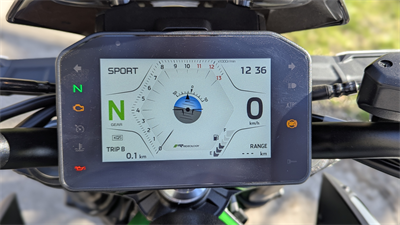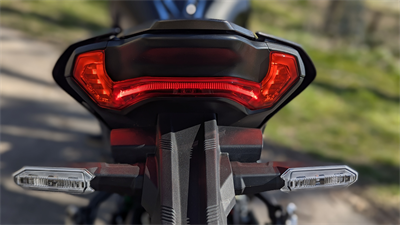Kawasaki Z 900
Kawasaki Z900 2025 Review (Baujahr 2025)
What can the new Streetfighter from Kawasaki do?
 Photos: Motorradtest.de
Photos: Motorradtest.deFinally - the new Z900 !
That's it, the new Z900. In black and green. Actually, there has to be at least a little bit of green, after all, it's a Kawa. However, we also find the very black one really tempting. The Sugomi design has been carefully refined, but the machine is still instantly recognizable as the Z900 even seven miles upwind.

Color selection of the "normal" Z900 vintage 2025. We would take the whole tie.
By the way, we were provided with a Z900 with a performance package from Heller & Soltau as a test machine for this test. The Performance package costs 1,450 euros extra and includes a tinted flyscreen, a pillion cover, a very effective screen protector and the rear silencer from Akrapovic including heat protection. Do you have to have that? We think not, but if you have the money - it's a nice bonus.

360 degree tour around the new Kawasaki Z900



New technology in the new Z900
Most of the updates were in the technology. There is now a QuickShifter with blipper, lean angle sensors, cruise control and a large, easy-to-read color display as standard. Ride by wire, three riding modes (Sport, Road and Rain) and traction control coupled to them have remained. The cockpit is easy to operate and runs via four switches on the left handlebar.
The Kawasaki app is not in order. By the time it could be properly and permanently coupled with the machine, we had almost lost our nerve. And then the disappointment: Where is the announced arrow navigation that you should be able to put on the display? Either the function is not yet integrated into the app or we were too stupid to find it. Kawasaki, that's not okay! Please revise the app, thank you.
Without an app, however, we feel right at home on the new Z900 in terms of operation and cockpit. Except for the missing turn signal reset, everything is on board that belongs to it these days. We find the cornering ABS particularly cool, a real plus in safety.
The lighting comes entirely in LED. At the rear, Kawa has replaced the Z signature in the rear light with a continuous light strip. Very, very chic. And from the front, the new Z900 looks just as evil as ever.
 On our Performance Z900 roars an Akrapovic rear silencer - designed for Z900. Roar.
On our Performance Z900 roars an Akrapovic rear silencer - designed for Z900. Roar.This is how it drives
The soundcheck exceeds our expectations! The Akra hisses and roars and lets the typical 4-cylinder concert sound. We forgot to write down the dbA value for the stationary noise, but it doesn't matter: The Z900 sounds strong and we just assume that it's no different with the standard exhaust. However, the look is a little old-fashioned, but that's why there is the Akra and other bags from the secondary market. Engine of the Z900: A work of art, and not only visually.
Engine of the Z900: A work of art, and not only visually. Nissin brake system on the Z900. Radially bolted 4-piston fixed calipers with very good braking performance.
Nissin brake system on the Z900. Radially bolted 4-piston fixed calipers with very good braking performance. Sure, design is a matter of taste as always, but we like it very much.
Sure, design is a matter of taste as always, but we like it very much.Result
Dummy Text. This dummy text is not very informative.Lorem ipsum dolor sit amet, consetetur sadipscing elitr, sed diam nonumy eirmod tempor invidunt ut labore et dolore magna aliquyam erat, sed diam voluptua.
At vero eos et accusam et justo duo dolores et ea rebum. Stet clita kasd gubergren, no sea takimata sanctus est Lorem ipsum dolor sit amet. Lorem ipsum dolor sit amet, consetetur
Price/availability/colours/years of manufacture
- Price: 9.845€
- Used (3 years old): 7.000€
- Years of manufacture: 2017 - present
- Colours: black-green, black-red, black-black












Further tests
Kawasaki Z900
Review
Kawasaki Z 900 (2020)
Review
Kawasaki Z 650 RS reviewed
Review
KAWASAKI Z900RS
Review
KAWASAKI VERSYS 1000 / VERSYS 1000 SE Crossover GrandTourer
Review